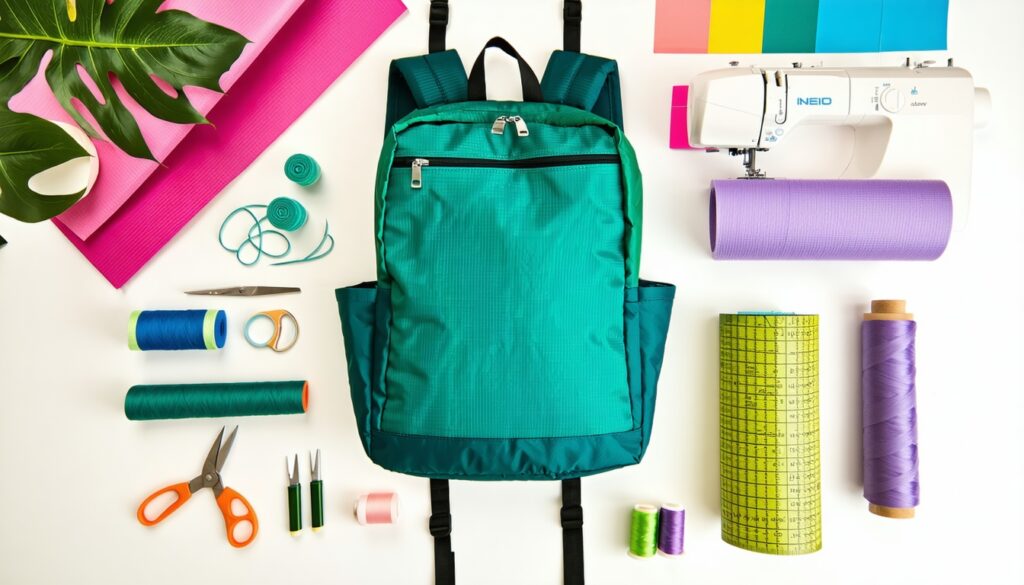How to Sew Your Own Custom Yoga Bag with Mat Compartment

Crafting Your Yoga Bag
Creating a custom yoga bag with a mat compartment is a rewarding project for health-conscious individuals who want a practical and stylish way to carry their yoga gear. The first steps in this process involve selecting the right fabric and preparing the fabric pieces for sewing.
Choosing the Right Fabric
Selecting the appropriate fabric is crucial for the durability and functionality of the yoga bag. The outer and lining fabrics can be cut from medium-weight outdoor fabric, which provides strength and resistance to wear. If a lighter weight fabric is chosen, interfacing may be necessary to stiffen the material and maintain the bag’s shape.
When selecting fabric, consider the following options:
| Fabric Type | Characteristics |
|---|---|
| Canvas | Durable and water-resistant, ideal for outdoor use. |
| Nylon | Lightweight and easy to clean, but may lack structure. |
| Neoprene | Offers cushioning and flexibility, great for a snug fit. |
Cutting and Preparing Fabric Pieces
Once the fabric is chosen, the next step is to cut the necessary pieces for the yoga bag. The tutorial provides specific dimensions for the fabric pieces required:
- Two pieces of fabric: 9 x 28 inches (for the main body)
- Two circles: 7 inches in diameter (for the bag ends)
- One piece of fabric for the strap: 35 x 5 inches
Optional steps may include cutting strips for bias tape, which can be used for finishing edges or adding decorative elements.
After cutting the fabric, it is important to prepare the pieces by pressing them to remove any wrinkles. This ensures that the fabric lays flat and makes sewing easier. Additionally, if using interfacing, it should be applied to the lighter weight fabric pieces to provide extra support.
By carefully choosing the right fabric and accurately cutting the pieces, individuals can set a solid foundation for creating their dream yoga bag. For more tips on selecting the best materials, check out our guide on how to choose the right yoga backpack for your practice.
Sewing the Body of the Bag
Creating the body of the yoga bag is an essential step in ensuring it is both functional and stylish. This section will guide you through constructing the front pocket and sewing the bag bottom.
Constructing the Front Pocket
To begin, the front pocket adds both style and practicality to the yoga bag. It can be used to store small items like keys, a phone, or a water bottle. The construction process involves cutting the appropriate fabric pieces and sewing them together.
- Cut the Fabric: For the front pocket, cut a piece of fabric that measures approximately 9 x 10 inches. This size can be adjusted based on personal preference.
- Sew the Pocket: Fold the top edge of the pocket fabric down about half an inch and sew it to create a hem. Then, fold the fabric in half, right sides together, and sew the sides and bottom, leaving the top open.
- Turn the Pocket: Turn the pocket right side out and press it flat. This will give it a neat finish.
- Attach the Pocket: Position the pocket on the front panel of the bag and sew it in place, ensuring it is securely attached.
For more detailed instructions on fabric cutting and preparation, refer to the tutorial on how to choose the right yoga backpack for your practice.
Sewing the Bag Bottom
The bag bottom is crucial for providing structure and stability to the yoga bag. Here’s how to sew it:
- Cut the Bottom Fabric: Cut a piece of fabric that matches the dimensions of the bag’s base. A common size is a rectangle measuring 9 x 28 inches, which corresponds to the main body of the bag.
- Prepare the Edges: If using a lighter weight fabric, consider adding interfacing to stiffen the fabric for better durability (Online Fabric Store).
- Sew the Bottom: Align the bottom piece with the main body of the bag. Pin it in place and sew along the edges, ensuring a secure attachment.
- Finish the Seams: To prevent fraying, finish the seams with a zigzag stitch or a serger if available.
This step is vital for ensuring that the bag can hold its shape and withstand the weight of the yoga mat and other gear. For additional tips on maintaining your yoga bag, check out our guide on how to clean and maintain your yoga backpack.
By following these steps, the body of the yoga bag will be well on its way to completion, ready to carry all the essentials for a yoga session.
Adding Functional Features
In this section, the focus is on adding practical features to the yoga bag, specifically creating the drawstring channel and making the bag strap. These elements enhance the functionality and usability of the bag, making it easier to carry yoga gear.
Creating the Drawstring Channel
To create a drawstring channel, a piece of fabric measuring 24.5″ x 8″ is needed. This fabric will serve as the casing for the drawstring. The steps to create the channel are as follows:
- Prepare the Fabric: Fold the fabric in half lengthwise, with the right sides facing each other. Press the fold to create a crease.
- Sew the Edges: Sew along the long edges, leaving the ends open. This will form a tube.
- Turn the Tube: Turn the fabric tube right side out.
- Insert the Drawstring: Use a safety pin to thread the drawstring through the channel. The drawstring allows for easy access to the yoga mat and can be secured with a cordlock for convenience.
| Step | Description |
|---|---|
| 1 | Prepare the fabric (24.5″ x 8″) |
| 2 | Sew along the long edges |
| 3 | Turn the tube right side out |
| 4 | Insert the drawstring through the channel |
Making the Bag Strap
The bag strap is essential for carrying the yoga bag comfortably. It should be made from an 8″ x 36″ strip of fabric. Here’s how to create the strap:
- Prepare the Fabric: Fold the fabric strip in half lengthwise with the wrong sides facing each other. Press the fold.
- Press Edges: Press both long raw edges towards the center fold to create a neat finish.
- Sew the Strap: Sew down both sides of the strap to secure the edges.
- Attach the Strap: Fold over the short ends to hide the raw edges and sew the strap to the outside of the bag. Reinforcement stitches should be added for security.
| Step | Description |
|---|---|
| 1 | Fold the fabric strip (8″ x 36″) in half |
| 2 | Press edges towards the center fold |
| 3 | Sew down both sides of the strap |
| 4 | Attach the strap to the bag with reinforcement stitches |
By incorporating these functional features, the yoga bag becomes more practical and user-friendly, allowing health-conscious individuals to carry their yoga gear with ease. For more tips on selecting the right bag, check out our guide on how to choose the right yoga backpack for your practice.
Assembling the Bag
Assembling the yoga bag is an exciting step in the process. This section will guide you through inserting the bag lining and attaching the drawstring, ensuring your custom yoga bag is both functional and stylish.
Inserting the Bag Lining
To begin, the bag lining needs to be prepared and inserted into the main body of the bag. The lining serves to give the bag a polished look and adds durability.
- Prepare the Lining: Cut the lining fabric to match the dimensions of the bag body. Ensure that the lining is slightly smaller than the outer fabric to allow for easy insertion.
- Sew the Lining: Sew the edges of the lining together, leaving an opening at the bottom for turning the bag right side out later.
- Insert the Lining: Place the lining inside the bag body, aligning the top edges. The right sides of the fabric should be facing each other.
- Pin and Sew: Pin the top edges together and sew around the opening, securing the lining in place.
This step is crucial for creating a neat finish. For more tips on choosing the right materials, check out our guide on how to choose the right yoga backpack for your practice.
Attaching the Drawstring
The drawstring closure is a functional feature that allows for easy access to the yoga mat. Here’s how to create and attach it:
- Create the Drawstring Channel: Cut a piece of fabric measuring 24.5″ x 8″ for the drawstring casing. Fold it in half lengthwise with the wrong sides facing, then press.
- Sew the Channel: Sew along the long edge and one short edge, leaving the opposite short edge open. This will create a channel for the drawstring.
- Insert the Drawstring: Use a safety pin to thread the drawstring through the channel. The drawstring can be made from a sturdy cord or fabric strip.
- Secure the Ends: Once the drawstring is in place, you can insert the ends through a cordlock for added convenience. This allows for easy adjustment and keeps the bag securely closed.
The drawstring closure not only enhances the bag’s functionality but also adds a stylish touch. For more insights on different types of yoga bags, check out our comparison of yoga mat backpack vs tote vs strap: pros and cons.
By following these steps, your yoga bag will be well on its way to completion, ready to carry your gear to classes, studios, or while traveling.
Personalizing Your Bag
Personalizing a yoga bag not only enhances its functionality but also adds a unique touch that reflects individual style. This section covers how to customize your bag with embellishments and how to add extra pockets for improved organization.
Customizing with Embellishments
Adding embellishments to a yoga bag can transform it from a simple accessory into a stylish statement piece. Techniques such as topstitching, basting, pinning, and handstitching can be employed to create decorative elements. For reinforcement, a box X stitch can be used, providing both style and durability.
When selecting embellishments, consider using contrasting fabrics or decorative stitching to highlight certain areas of the bag. A drawstring yoga mat bag pattern can include features like an outside pocket and a pocket near the top for small items, allowing for both practicality and flair. This type of bag can be made from a solid color or multiple colors for a scrappy look, making it a thoughtful gift for a yoga-loving friend.
| Embellishment Type | Description |
|---|---|
| Decorative Stitching | Adds visual interest and can reinforce seams. |
| Fabric Patches | Personalizes the bag with unique designs or logos. |
| Beads or Buttons | Provides a playful touch and can be functional. |
Adding Extra Pockets
Incorporating extra pockets into a yoga bag enhances its functionality, allowing for better organization of yoga essentials. A well-constructed bag can feature a front pocket for easy access to items like keys or a phone, as well as additional pockets inside for smaller accessories.
When designing the bag, consider the following pocket placements:
| Pocket Location | Purpose |
|---|---|
| Front Pocket | Quick access to essentials like a phone or wallet. |
| Inside Pockets | Organizes smaller items such as hair ties, essential oils, or snacks. |
| Side Pockets | Ideal for water bottles or yoga blocks. |
A drawstring yoga mat bag pattern can include these features, ensuring that the bag is not only stylish but also practical. The construction process involves creating a pocket for the front of the bag, sewing the lining, and inserting the bag lining into the main bag.
By personalizing the bag with embellishments and adding extra pockets, individuals can create a yoga bag that meets their specific needs while showcasing their personal style. For more tips on selecting the right yoga bag, check out our guide on how to choose the right yoga backpack for your practice.
Finishing Touches
Completing the yoga bag involves securing seams and edges, as well as finalizing the drawstring closure. These finishing touches ensure that the bag is both functional and stylish.
Securing Seams and Edges
To enhance the durability of the yoga bag, it is essential to secure all seams and edges properly. The bag strap should be made from an 8″ x 36″ strip of fabric. This strip is folded in half lengthwise with the wrong sides facing each other. Both long raw edges should be pressed towards the center fold. After pressing, the strap should be sewn down both sides to create a sturdy strap. Reinforcement stitches can be added for extra security when attaching the strap to the bag.
| Strap Dimensions | Fabric Strip Size |
|---|---|
| Length | 36″ |
| Width | 8″ |
Finalizing the Drawstring Closure
The yoga bag features a drawstring closure, which is both practical and aesthetically pleasing. To create the casing for the drawstring, a 24.5″ x 8″ piece of contrast print fabric is used. This piece is sewn into a channel where the drawstring will be inserted. The drawstring can be a string or rope, and it is inserted through the channel for easy access to the yoga mat. A safety pin or bodkin can be used to help thread the drawstring through the casing, or it can be sewn in place to avoid the hassle of threading it later.
| Drawstring Casing Dimensions | Fabric Piece Size |
|---|---|
| Length | 24.5″ |
| Width | 8″ |
These finishing touches not only enhance the functionality of the bag but also contribute to its overall appearance. For more tips on creating the perfect yoga bag, check out our guide on how to choose the right yoga backpack for your practice.


